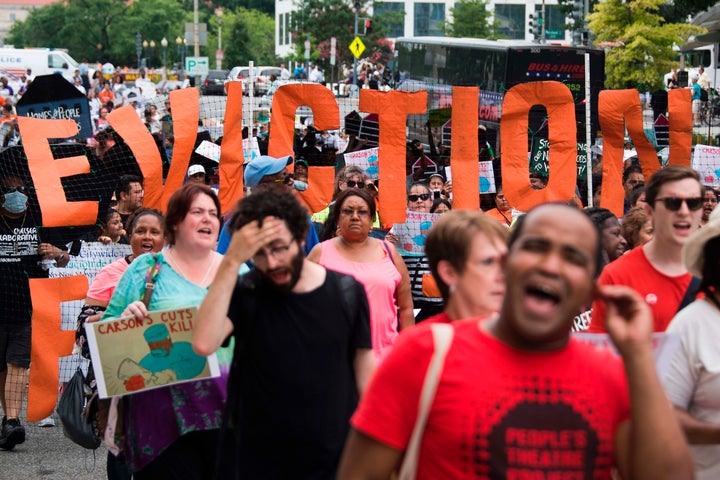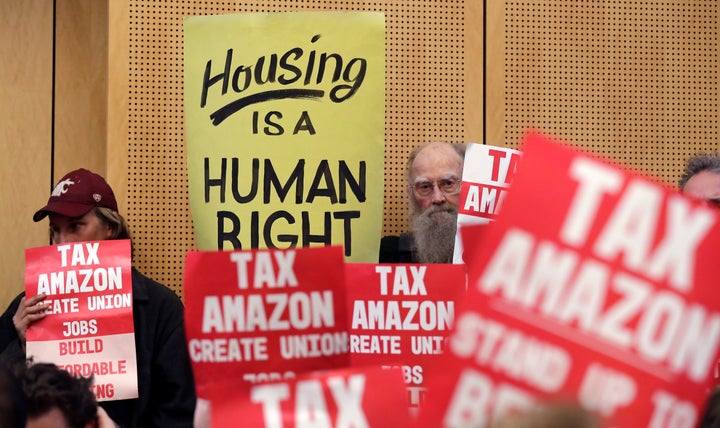Homelessness affects hundreds of thousands of Americans on any given day, and yet many people still perpetuate wrong and at times harmful stereotypes about those struggling to access housing.
Last year, more than 500,000 people were homeless across the country on a given night in January, according to the U.S. Department of Housing and Urban Development.
While there’s been a decline in the number of homeless Americans over the last decade, last year saw the first increase in recent years, per the HUD report.
The issue is getting notably worse in certain areas, as the country’s affordable housing crisis makes it harder for people to afford rent in big cities, and even small cities and some rural areas.
New York City, for instance, reached a record high for homelessness in 2017, with an average of 63,495 people sleeping in the city’s shelters each night, according to nonprofit Coalition for the Homeless. Three-quarters of those in shelters were families, including 23,600 children.
Here’s a fact check on some all-too-common and harmful stereotypes about people who are homeless.

Myth 1: Most homeless people live on the streets.
Of the roughly half-million Americans homeless on a single night in 2017, about two-thirds (65 percent) were living in shelters or transitional housing, while about one-third (35 percent) were “unsheltered,” or living on the street or in abandoned buildings, according to HUD.
These figures vary by region: In the San Francisco Bay Area in 2017, about 4,350 of 7,500 homeless people were considered “unsheltered” ― or 58 percent.
Many people who are homeless are also not in shelters or on the street, but living in their cars or “doubled up” at friends’ homes ― situations that can be unsustainable and even unhealthy.
“It’s much easier to look around and see people in the streets as the problem — and not see it’s the broken system.”
- Shahera Hyatt, director of the California Homeless Youth Project
Myth 2: Most homeless people are mentally ill.
About 20 percent of people who were homeless had a serious mental illness, according to a 2016 U.S. Department of Health and Human Services report. For homeless people living on the streets, those figures tend to be higher. People with mental health issues can be particularly vulnerable to becoming homeless, and once they’re homeless, it can be hard to access care.
While free medical care may be available to homeless residents through clinics, shelters or homeless services organizations, some people may be hesitant to seek treatment because of negative experiences they’ve had in clinics. “Or they’re in denial that they even have medical issues,” one expert told HuffPost in 2016.
“When folks say that people become homeless because of a mental health issue or a substance use issue, I usually like to say, ‘people don’t become homeless because of those issues, it’s because we don’t have a system in society to support people having a mental health crisis or a substance use issue,’” Shahera Hyatt, director of the California Homeless Youth Project, said in a conference speech earlier this year.
“Because not all people having those issues experience homelessness,” she added. “It’s the folks living in poverty who often lack the social safety net to buoy them through the storm.”
Myth 3: Most homeless people are addicts.
About 17 percent of people who are homeless also suffer from a chronic substance use disorder, according to the U.S. Department of Health. Mental health and substance abuse issues can be connected, as people suffering from mental illness who lack access to treatment may try to “self-medicate” with drugs or alcohol.
While most homeless shelters require residents to be substance-free, some operate as “wet” shelters, in an effort to meet residents where they are by either letting people drink on the premises or not barring people under the influence of drugs or alcohol from accessing beds.
“We’re just focused on the fact that people living with addictions and mental health issues aren’t going to get any better if they are living outside,” Greg Jensen, the director of one such program in Seattle, told HuffPost in 2015. “If we can bring them inside, they’re closer to getting services that they need; we’d be in a better position to help them.”

Myth 4: Homeless people just need to get a job.
Many people who are homeless also work. A 2017 survey of homeless residents in San Francisco found that 13 percent were working full-time, part-time, or had seasonal, temporary or casual employment. Of those who were unemployed, the primary barriers to employment they cited were lack of transportation (36 percent) and lack of a permanent address (36 percent.)
In Los Angeles County, which has more than 50,000 residents who are homeless, about 27 percent of homeless adults with children said they were working either part or full time.
But even with a job, it can be a challenge to pay rent or a mortgage ― never mind initial deposits often needed to secure a place to live. In any state across the U.S., a person who earned the minimum wage could not afford a modest two-bedroom apartment, according to a National Low Income Housing Coalition report from earlier this year.
“There is not enough low-income housing,” Monica Steptoe, associate director at a San Francisco youth homeless shelter, told HuffPost last month. She noted that the San Francisco Bay Area’s notoriously high housing prices make it hard for homeless people to access affordable housing. “People can’t even afford housing who have jobs.”
“Not all people having [mental health or substance abuse] issues experience homelessness ― it’s the folks living in poverty who often lack the social safety net to buoy them through the storm.””
- Shahera Hyatt
Myth 5: It’s their fault they’re homeless.
As the National Alliance to End Homelessness puts it, “the solution to homelessness is simple ― housing.” Yet affordable housing is hard to come by in America: Over the past few decades, housing costs have risen far faster than incomes. And homeless advocates say that governments at the federal, state and local levels have not done enough to make more affordable housing available.
“When you ask someone on the street why they became homeless, no one’s going to say it’s because of decades of federal disinvestment in affordable housing,” Hyatt told HuffPost in 2016. “It’s much easier to look around and see people in the streets as the problem — and not see it’s the broken system.”
Also, some populations are more vulnerable to homelessness through no fault of their own.
Approximately 40 percent of youth served by homeless youth organizations in the U.S. identify as LGBTQ, according to a 2012 report. One of the top reasons queer youth listed for becoming homeless was running away from home or being forced out of their homes after being rejected by their families because of their sexual orientation or gender identity.
What’s more, at age 18, many young people become too old to be placed in a foster home. Nearly 40 percent of foster youth who “age out” of the system later become homeless, according to nonprofit Covenant House. Many young adults who are homeless also don’t feel safe staying in adult shelters.
People of color in the U.S. also experience homelessness at higher rates than whites, according to the National Alliance to End Homelessness. Black Americans, for instance, make up more than 40 percent of homeless people, but only about 13 percent of the total U.S. population.

